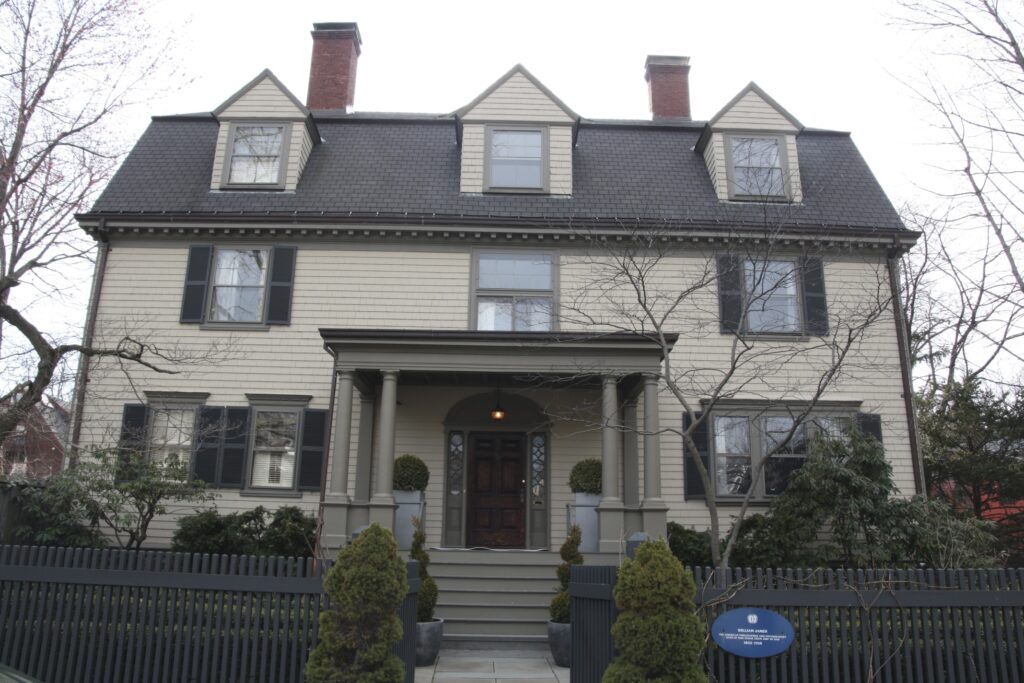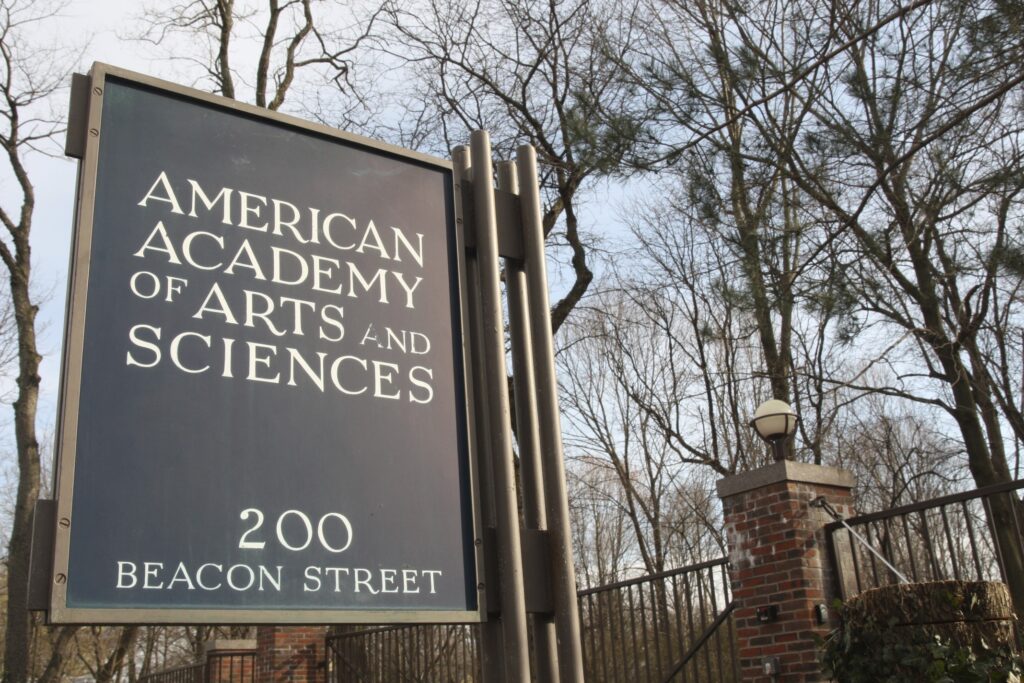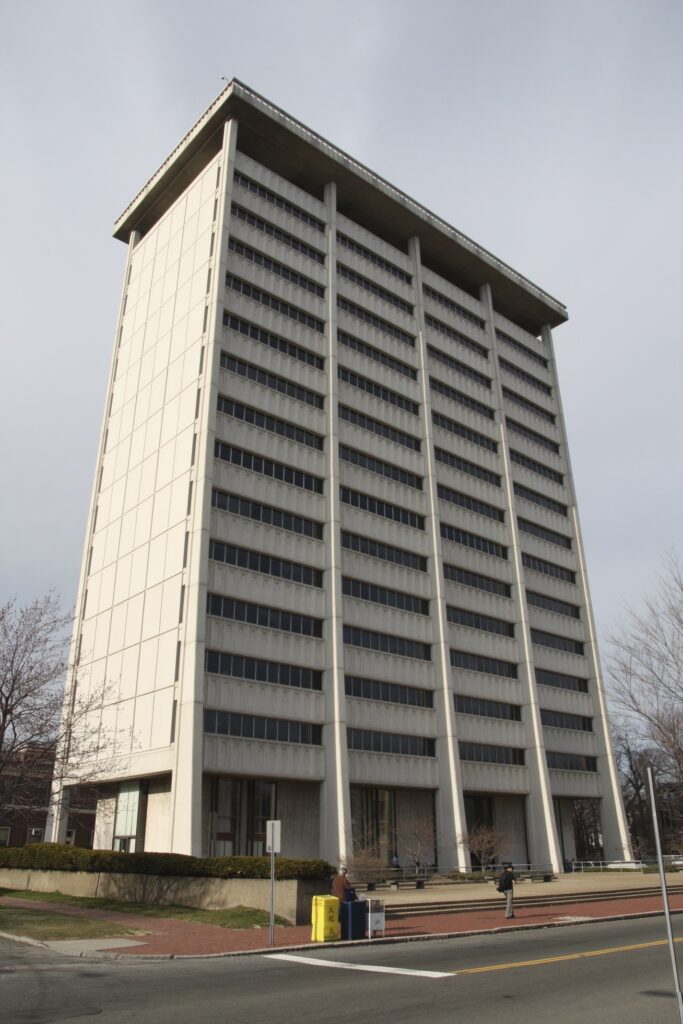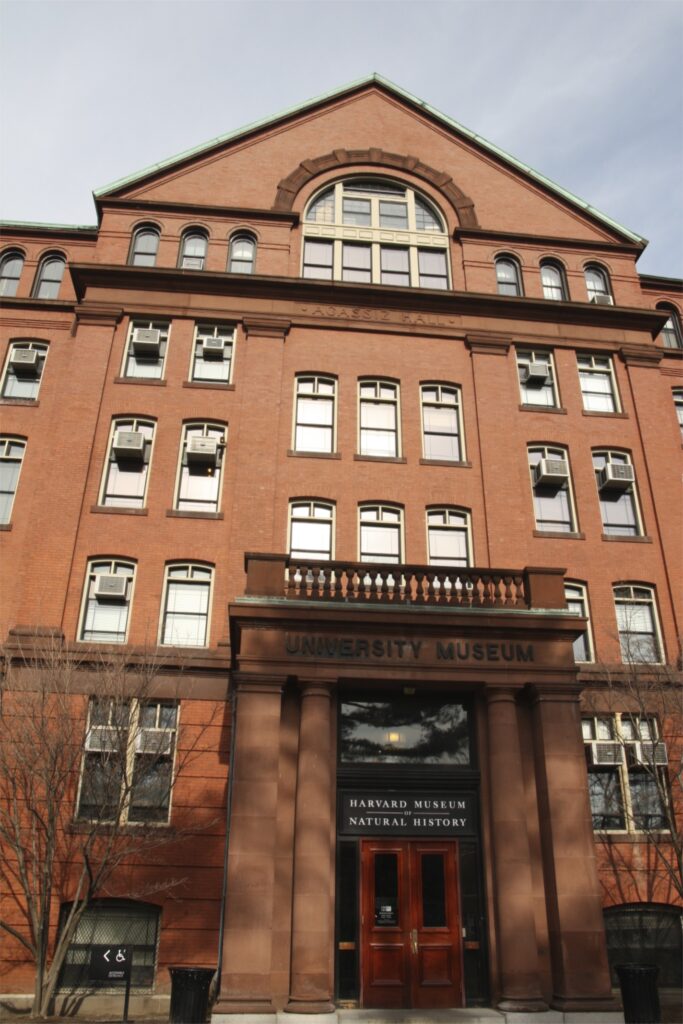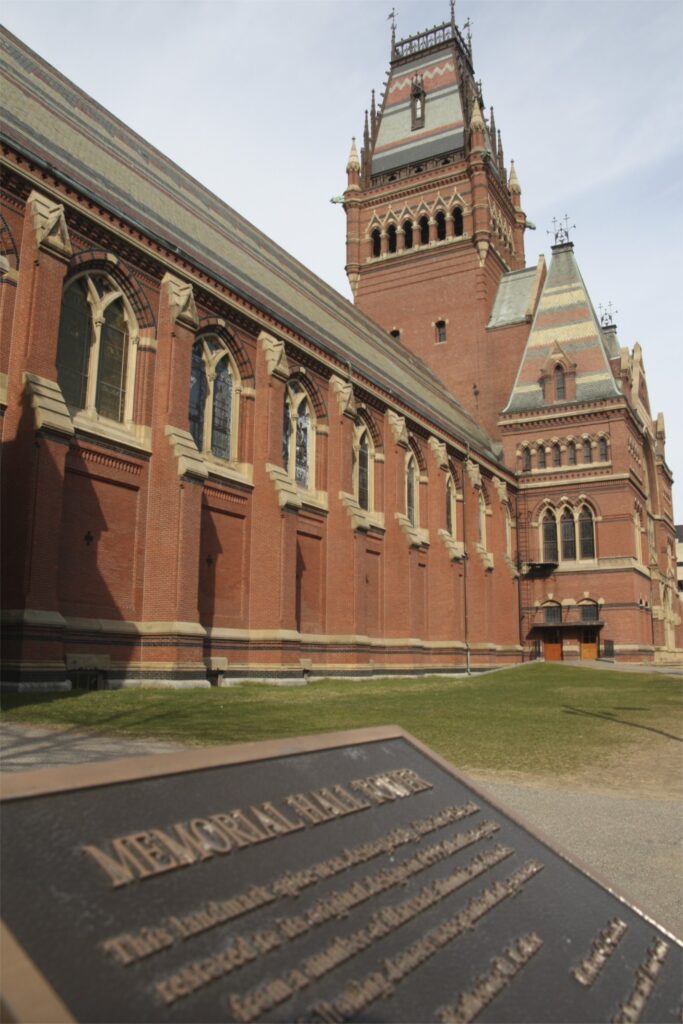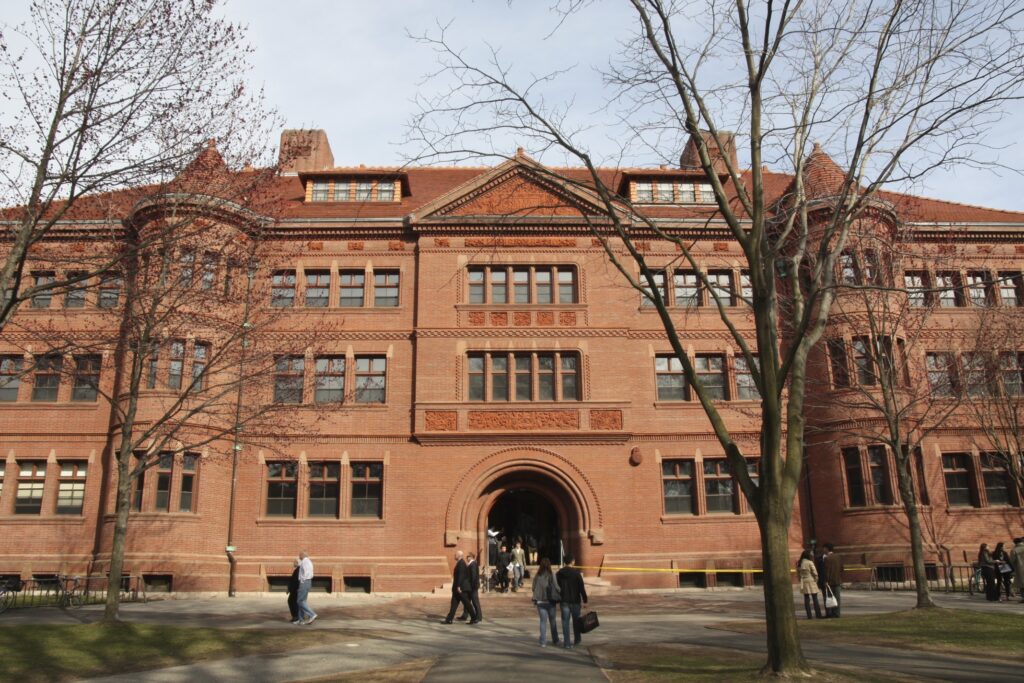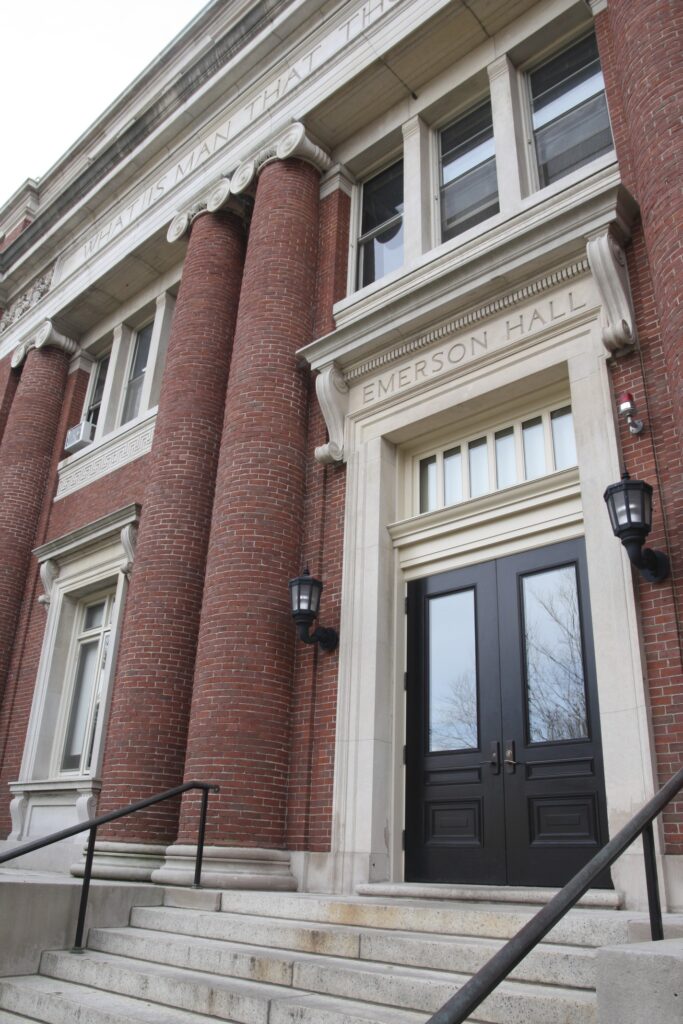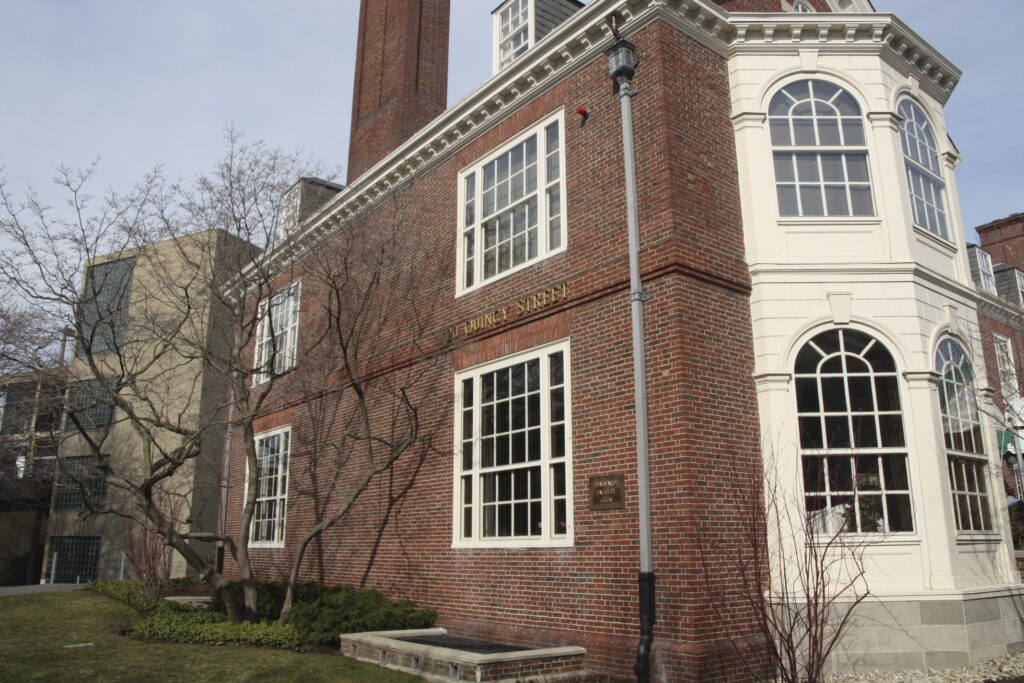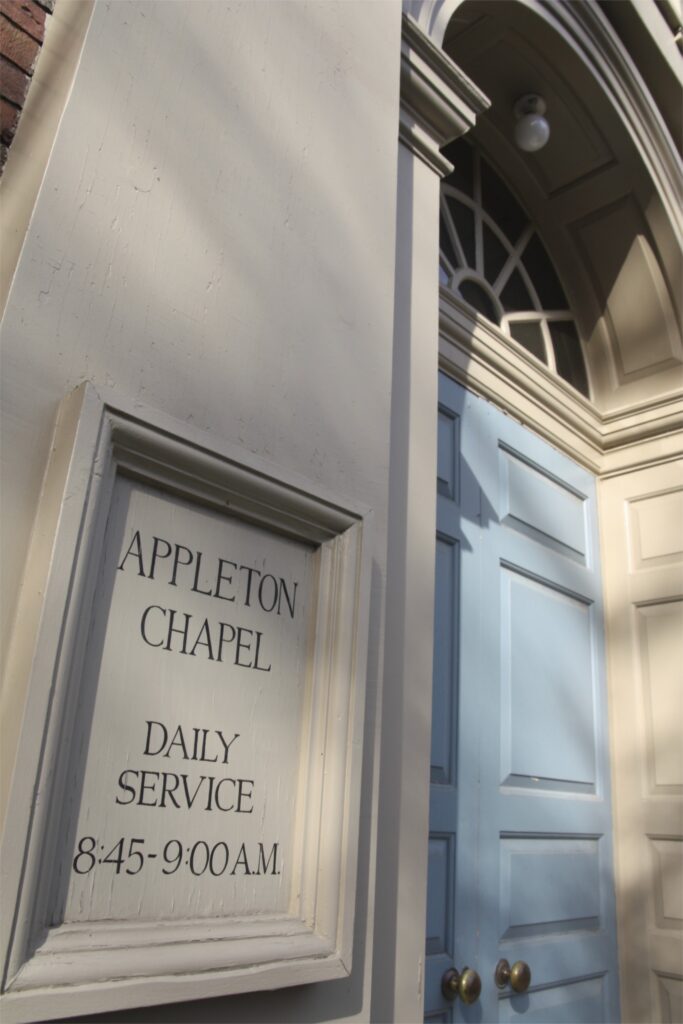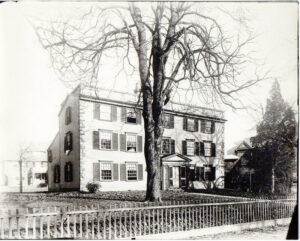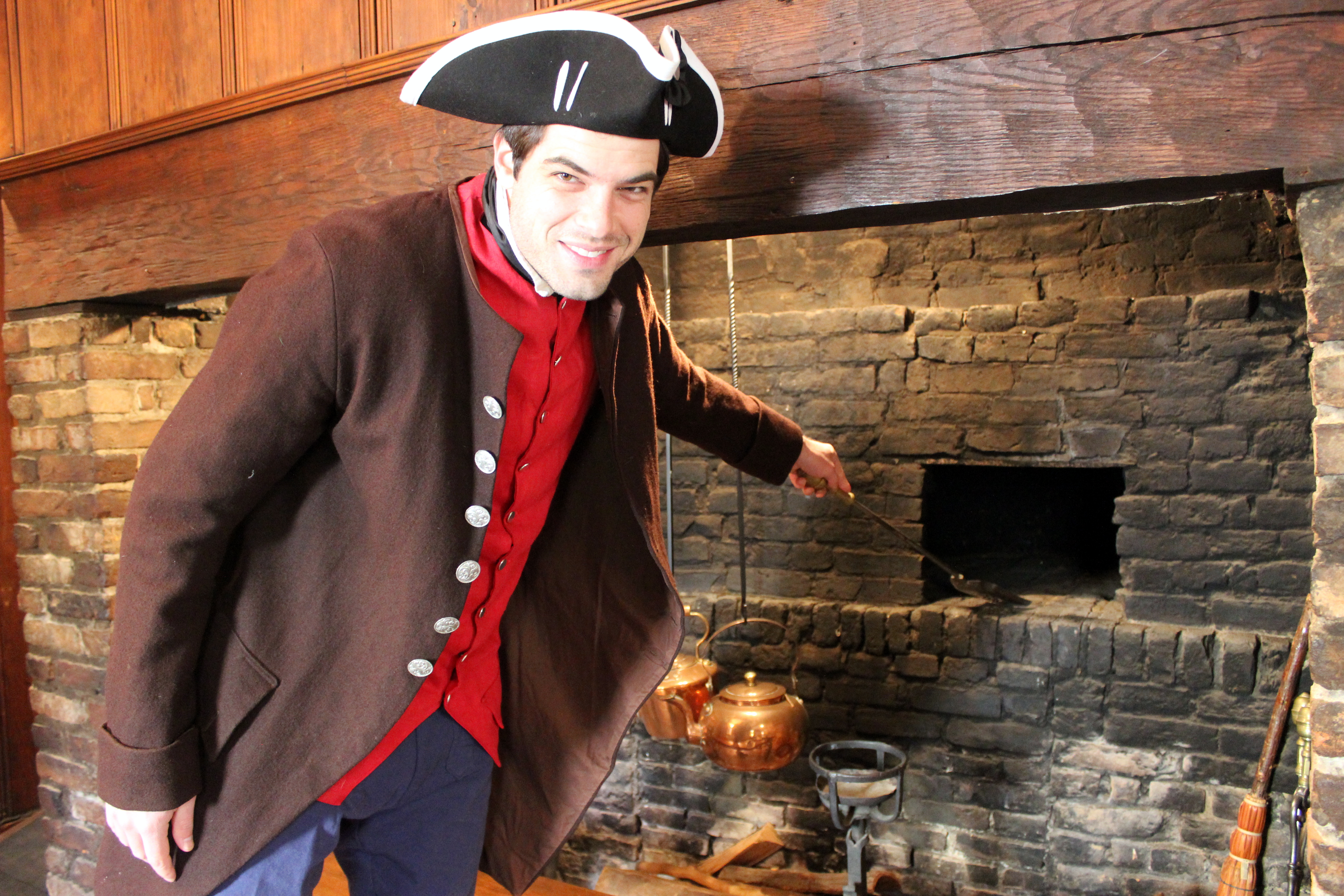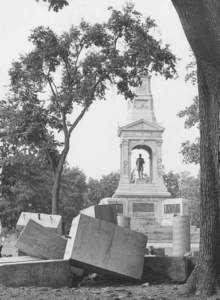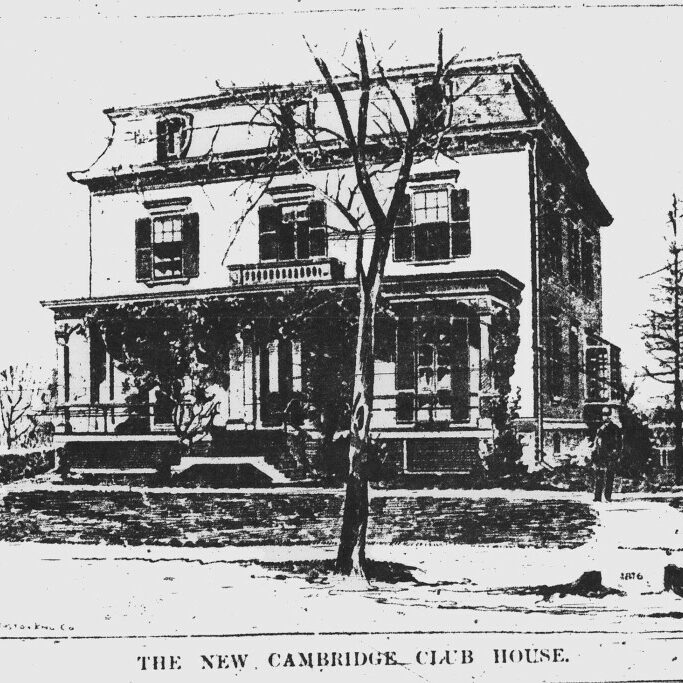
Self-Guided Tour: William James’s Cambridge
By Natalie Moravek, Intern, 2010
Stop #1: 95 Irving Street, Home to William James and Family
The house at 95 Irving Street was built in 1889 for William James and designed by architect William Ralph Emerson in conjunction with James, who lived there with his family from 1889 to his death in 1910.
The William James House is architecturally significant as the work of William Ralph Emerson (1833-1918), a Boston architect who is best known for his Shingle Style designs, a number of which survive across New England. Emerson was a distant cousin of Ralph Waldo Emerson, who was close to Henry James Senior and blessed young William as a child.
William James lived in Cambridge for more than fifty years, but it is this home on Irving Street that was most special. James was so eager to occupy the home that he even moved the family in before construction was complete. Letters to friends and family are full of praise for the house, especially its grand library-study–which is 22 feet wide and 27 feet long with floor-to-ceiling bookcases and has been preserved, along with the principle rooms of the first and second floor, through recent renovations.
One of James’s major works, The Principles of Psychology (1890), was written over a 12-year period preceding the construction of his house, but all of his later work was written while James resided on Irving Street, and it is this work that established his lasting influence in the fields of philosophy, psychology and educational theory. Among the works James published while resident on Irving Street are The Will to Believe and Other Essays in Popular Philosophy (1897), Talks to Teachers on Psychology; And to Students on Some of Life’s Ideals (1899), The Varieties of Religious Experience (1902), Pragmatism: A New Name for Old Ways of Thinking (1907), A Pluralistic Universe (1909), The Meaning of Truth (1909), and Some Problems in Philosophy (1911).
At the death of William James in 1910, the property passed first to William James’ widow, Alice Howe Gibbens James and, on her death in 1922, in four shares to their children, Henry, William, Alexander and Margaret. Members of the James family occupied the house until 1968, when James’s grandson sold the property to the President and Fellows of Harvard College. The President and Fellows of Harvard College retained ownership of the house until 1981 when it was purchased by Professor William Estes, who bought the house with the provision that Harvard had the right of first refusal to buy it when Estes wished to sell.
Estes proudly considered his home an extension of the Harvard psychology department, which is housed in Harvard’s William James Hall. Estes hosted parties for the department to welcome incoming psychology students, talk about James and explain the house’s rich history. Estes sold the house in 1999 to a private owner after the President and Fellows of Harvard College declined to exercise a right of first refusal to purchase the property, stating that the purchase of expensive real estate was not an appropriate way to meet academic space needs.
In his own time, though, William’s house was an academic space. James hosted students such as Gertude Stein and Marry Calkins, the first female president of the American Psychological Association, graduate student Edward Thorndike who used the basement here to raise the chickens he used to study animal intelligence, and scholars like neighbor and friend Josiah Royce.
Stop #2: 103 Irving Street, Home to Josiah and Katherine Royce
Just like the James home, the Royce home was built in 1889.
For nearly 30 years, Josiah Royce and William James were colleagues in the same department of philosophy at Harvard. During most of that time, they lived as neighbors where, on returning from class, they often entered into lengthy and sometimes heated philosophical discussions. Royce and James had always disagreed deeply concerning the proper understanding of religious phenomena in human life. Their friendly longstanding dispute was known as the Battle for the Absolute.
Contrary to the open-ended pluralism and pragmatism of James, Royce was convinced that the object and source of religious experience was an actual, infinite, and superhuman being. As Alice James once said, Royce carried “his Infinite under his arm.”
In 1899 and 1900, Royce delivered the Gifford lectures at the University of Aberdeen, which were published as The World and the Individual. When James delivered the Gifford Lectures in 1901 and 1902, he directed many arguments against Royce’s idealism, though he did not target his friend by name. James’s lectures were published as the popular and academic success The Varieties of Religious Experience. Though the two were very different, James quite charming and Royce socially awkward, James trim and smartly dressed and Royce stocky and frumpy, they remained close friends throughout their lives. While William was on sabbatical in 1892, Royce wrote to him that “Cambridge without you is like toast unbuttered, like the heart without blood.”
Note: The property was later home to Julia Child and her taped cooking shows. Child sold the house and spent her last years in California, but in 2001 the kitchen in its entirety was removed and sent to the Smithsonian’s National Museum of American History.
Stop #3: 107 Irving Street, Eliza Gibbens’ Cambridge home
William’s wife Alice Howe Gibbens James is much attributed with creating emotional stability in the James family, for not only William, but also for Henry.
As the story goes, Henry Sr. returned home from a Boston Radical club meeting one night in 1876 to announce that he had caught a glimpse of the woman who was to be William’s wife, a Boston school teacher. Her name was Alice Howe Gibbens (1849-1922).
Sure enough the two would be married, and together they had five children, Henry “Harry”, William “Billy”, Hermann, who died within a year, Margaret Mary “Peggy”, and Alexander, who would be called Tweedy, Francois, and finally Aleck.
Alice was a natural caregiver. After her father’s suicide in 1865, Alice, at age 16, took responsibility for her two younger sisters and her mother, Eliza Gibbens. Soon after their marriage, Alice began to work closely with her husband. Some of William’s manuscripts were delivered in Alice’s hand.
William started to experience heart pain in 1898, and Alice spent the next twelve years nursing him and traveling in search of a cure. During some of that time, their youngest son Aleck was left in the care of Alice’s mother at this residence. In his last days, William asked his wife to promise that she would take care of his brother Henry, who was soon to be the last living James sibling. Alice and Henry were actually quite close, and she made her way into his fiction in three stories: “The Impressions of a Cousin,” “Pandora” and “Lady Barbarina.”
Alice would of course make good on her promise to take care of Henry, and despite the war, she made her way to England in 1915 to be by his side in his last months. Henry died in early 1916 and was cremated, but Alice smuggled his ashes back to the United States; she buried them in Cambridge near the remains of his brother William, his sister Alice, his parents, and her son Hermann who had died as a baby.
Stop #4: 136 Irving Street, American Academy of Arts and Sciences
During the American Revolution, charter members including John Adams and John Hancock founded the American Academy of Arts and Sciences to provide a forum for scholars and all those working on behalf of democratic interests of the republic.
In the words of the Academy’s charter, enacted in 1780, the “end and design of the institution is…to cultivate every art and science which may tend to advance the interest, honour, dignity, and happiness of a free, independent, and virtuous people.”
During the 19th century, the elected membership included Daniel Webster, Henry Wadsworth Longfellow, Louis Agassiz, Ralph Waldo Emerson, Alexander Graham Bell, and William James, who was inducted in 1875. Fellow inductee in 1875 included Harvard history professor Henry Adams, grandson of John Quincy, and author of Pulitzer-winning personal biography The Education of Henry Adams.
James’s eldest son Henry, a writer, was inducted in 1931, followed the next year by another son William, a painter. (Henry was a VP and trustee of the Rockefeller Institute of Medical Research and a writer. He wrote biographies of Harvard President Charles William Eliot and Richard Olney, Secretary of State under Grover Cleveland. William was a painter associated with the school at the MFA as critic of painting and acting director.)
Members meet monthly at “Stated Meetings” which date back to the early years of the Academy. These gatherings were to occur from fall through spring on the second Wednesday evening of the month, as they still do in Cambridge.
Stop #5: William James Hall
Designed in 1963 by Minoru Yamasaki, famous for his design of the World Trade Center, William James Hall houses the Department of Psychology, which William James was instrumental in establishing.
In 1875, James taught one of the university’s first courses in psychology, “The Relations between Physiology and Psychology.” He joked that “the first lecture in psychology that I ever heard was the first I ever gave.” James also established the first U.S. experimental psychology laboratory, and oversaw Harvard’s first doctorate in psychology, earned by G. Stanley Hall in 1878.
In 1890 James published his highly influential, two-volume synthesis and summary of psychology, Principles of Psychology.
The books were widely read in North America and Europe, gaining attention and praise from Sigmund Freud and Carl Jung in Vienna. James would later meet both Freud and Jung at Clark University in 1909. It was Freud’s only U.S. trip, and the meeting between Freud and James was arranged by James’ former student G. Stanley Hall, then president of Clark.
The 15th floor has a William James conference room, in which hang portraits of the professor and his father and grandfather. William’s colleagues in the department of philosophy had the portrait commissioned, and when it was done James entertained the department at his house. It originally hanged in the Faculty Room of University Hall.
Stop #6: Swedenborg Chapel
Though this chapel, constructed in 1901, went up after Henry James Sr.’s death, and there is no clear record of the Jameses as part of this congregation, it is important to note the influence of Swedenborg on Henry Sr. and subsequently William.
In 1844, while living in England, Henry James Sr. was sitting alone one evening when he had the defining spiritual experience of his life, which he would come to interpret as a Swedenborgian “vastation,” a stage in the process of spiritual regeneration. James’s “vastation” initiated a spiritual crisis that lasted two years, and was finally resolved through exploring the work of Emanuel Swedenborg (1688-1772), the Swedish scientist turned mystic. Swedenborg was considered a mystic based on his claim that the Lord had appeared to him and appointed him to reveal the spiritual meaning of the Bible. Most of all, Swedenborg was convinced that the Bible describes a human’s transformation from a materialistic to a spiritual being, which he calls rebirth or regeneration.
It is part of the conventional wisdom about the James family that the elder Henry James had a large influence on his son, William James, in the direction of religious interests. But William neither adopted his father’s spirituality nor did he regard it as a foil to his own secularity. However, William did promise his father that one day he would deal with religion, and his The Varieties of Religious Experience provided a wide-ranging account of religious experiences, including his father’s mysticism, interpreted according to his pragmatic leanings.
Ironically, the Swedenborg chapel stands among buildings that, though not original to its setting, are nonetheless historically or functionally related to it in various ways. Gund Hall houses the Graduate School of Design which was founded by the chapel’s architect, Langford Warren. Within sight of the chapel stand William James Hall, and its original neighbor the Treadwell-Sparks House which once stood connected to the chapel and housed the Swedenborg School of Religion.
Stop #7: Museum of Comparative Zoology
The MCZ was founded in 1859 primarily through the efforts of Professor Louis Agassiz, a brilliant lecturer and scholar from Switzerland who had made his reputation with a book on Brazilian fish. He was determined to fill the museum with the most valuable comparative zoology collection in America, and suspected that the Amazon was inhabited by many still unknown species.
In 1865, William James accompanied Agassiz on the Amazonian expedition. This museum, particularly the ichthyology department, houses much of the material collected by Agassiz and James on their trip.
Though James ultimately looked back on his time in the Amazon fondly, he soon discovered that collecting was not his forte. When he was not seasick, homesick, and sick with smallpox, James, a trained painter under William Morris Hunt of Newport, longed to paint the scenery and returned fluent in Portuguese.
James was briefly the acting head of the museum starting in the fall of 1874.
The Harvard Museum of Natural History was established in 1998 as the public face of the Museum of Comparative Zoology, along with the Harvard University Herbaria and the Mineralogical and Geological Museum.
Stop #8: Memorial Hall
Memorial Hall was erected in honor of Harvard graduates who fought for the Union in the Civil War.
Fundraising began in 1865 by an alumni committee that raised $370,000, a sum equal to one-twelfth of the endowment of the University. The cornerstone was laid in 1870.
This memorial space boasts a 2,600 square-foot marble floor with 28 white marble tablets bearing the names of 136 Harvard associates who fell on behalf of the Union cause during the Civil War. The youngest, Sumner Paine, class of 1865, fell at Gettysburg on July 3, 1863, two years before his intended graduation. The grandsons of Paul Revere are also listed, as well as William’s cousins Gus Barker and William Temple.
William’s younger brother Garth Wilkinson “Wilky” was the most committed abolitionist of the James family and served in Col. Robert Gould Shaw’s 54th Massachusetts Regiment, the first of two racially integrated in the state and the first black regiment recruited in any free state. During the futile assault on Fort Wagner, Wilky saw Shaw killed instantly, and was himself shot in the side and foot. Memorial Hall also has a plaque to Shaw, who was a Harvard student from 1856 to 1859 but withdrew before graduating.
In 1897, William gave the oration at the dedication of the monument to Col. Shaw that stands at the edge of the Boston Common. The bronze relief sculpture depicts the officer riding beside a company of foot soldiers. At the dedication, William observed that it was the first American soldier’s monument dedicated to a group of citizens united in the interests of their country, rather than to a single military hero.
Robertson “Bob” James enlisted in the 55th Massachusetts Regiment, the second of the two integrated regiments formed in the state, but he did not distinguish himself in battle as his brother did.
The closest William would come to battle was in April of 1865 while sailing south for the Amazon with the Thayer Expedition. The passengers saw what they thought to be smoke of a decisive battle in Virginia. The smoke was from the Confederate forces, which set fire to Richmond before surrendering.
Stop #9: Sever Hall
Sever Hall, built from 1878-1880, was designed by famed American architect H.H. Richardson, whose most acclaimed work is Trinity Church in Copley Square.
James sometimes taught in this building, and his graduate student Dickinson S. Miller remembers a class with James in one of the tower rooms of the hall, saying James “looks more like a sportsman than a professor.”
Indeed, James did not look or talk or think like a professor. His restless energy and desire to explore, examine and experiment stood in contrast to other contemporaries, particularly Josiah Royce, who was formal and composed in the classroom.
His unorthodox methods are also exemplified in the infamous story of Gertrude Stein’s final examination. After reading the questions, Stein wrote in her examination book: “Dear Professor James, I am so sorry but really I do not feel like an examination paper in philosophy today.” Then she left the classroom. Next day she received the reply: “Dear Miss Stein, I understand perfectly how you feel. I often feel like that myself.” Then he gave her the highest mark of the class.
Stop #10: Emerson Hall
Emerson Hall is home of the Harvard philosophy department, which in James’ time included both philosophy and psychology. James was present at the dedication of the building in December 1905. The building was designed by Guy Lowell, also known in Boston for the Museum of Fine Arts.
James resigned his Harvard professorship just before his 65th birthday in 1907. He gave his last lecture here, at Emerson Hall, on January 22. His wife Alice and several colleagues were in attendance as he ended his lecture to ovation. His graduate students presented him with a silver-mounted inkwell and his undergrads gave a loving cup.
It’s no surprise that William would be a favorite to most students. He was one of the few professors of the period who permitted students to ask questions. More than that, they could stop him on campus or walk home with him to Irving Street discussing or arguing statements he had made in class. At the end of the term he would even ask students to write out criticisms of the course and make suggestions for improvements, and is thought to be the first college teacher in America to do so.
Stop #11: 20 Quincy Street
In 1866 the James family moved into an old house here at 20 Quincy Street. The house was demolished in 1930 to make way for the Harvard Faculty Club.
Here William’s parents would live for almost the remainder of their lives, and William himself for the next decade.
Living in this house placed the Jameses near to the people who would soon become some of the closest family associates. Half a block away the Agassizes built a three-story home. A few blocks further lived Charles Eliot Norton, then editor of the North American Review, to which Henry James Sr. and Jr. both contributed.
Charles Peirce, Oliver Wendell Holmes Jr., and Chauncey Wright were also frequent visitors, as their philosophical discussions with William at the house turned into the Metaphysical Club, which was never mentioned by any person in the club other than Peirce, but became the subject of a Pulitzer-Prize-winning book by Louis Menand.
Stop #12: Houghton Library, Home to the William James Papers
The collection, a gift of Mr. and Mrs. Henry James III, includes personal and professional correspondence of William James, including over 1300 letters to his wife Alice which were originally legally sealed to the public until the year 2023 by their son Henry, but have since been released by later executors removing the restrictions.
Also here: over 400 letters to his brother Henry, manuscripts, drafts, and notes on psychology, philosophy, and religion, diaries, 1865-1910 (with gaps), notes James took as a student, and James’s Brazilian diary and sketch book. Collection also contains photographs of the James family; student notes from James’ classes; letters to Ralph Barton Perry from James’s students and correspondence concerning Perry’s The Thought and Character of William James; correspondence of Henry James III in his search for William James’ letters; and printed material about William James.
Stop #13: Linden Street Boarding House
In 1861 William enrolled in the Lawrence Scientific School which was then only loosely associated with Harvard. Since he was not enrolled in the college, he did not participate in undergraduate social life or room in the Yard. Instead he rented rooms like this one, from Mr. and Mrs. John Pasco. He found the rooms he stayed in uncomfortable and was homesick for his family then in Newport.
However, William formed lasting friendships with some of his fellow students in the Scientific School. At Harvard James knew, either as teachers, lecturers, or students, many of the men who would play major roles in American science. Alexander Agassiz, who helped his father found the Museum of Comparative Zoology, Nathaniel S. Schaler, who became dean of the Scientific School, Alpheus Hyatt, for many years the curator of the Museum of Comparative Zoology, and Charles S. Peirce, a great influence on 20th century logic and semantics were among them.
Stop #14: Site of Appleton Chapel, where James’ memorial service took place
William James died of heart disease at his family’s summer home in New Hampshire on August 26, 1910. Of the autopsy, Alice wrote in her journal “acute enlargement of the heart. He had worn himself out.”
After a private memorial at Irving Street, his funeral was held on August 30 at Appleton Chapel which used to stand here. Harvard President Abbott Lawrence Lowell served as one of the pall bearers.
Appleton Chapel, a building dedicated solely to worship, was built in 1858, sited where The Memorial Church now stands.
When it was built, Morning Prayer attendance was compulsory. When attendance became voluntary in 1886, the College was left with a building that had become too large for the Morning Prayer services and too small for the Sunday services. Although there was talk of building a more suitable chapel for worship at Harvard, nothing was done until soon after World War I when Harvard University President Abbott Lawrence Lowell (1909–1933) combined the idea of a war memorial with the need for a new chapel.
William James was cremated at Mt. Auburn Cemetery and buried in the James family plot in Cambridge Cemetery.

